|
|
|---|
| Atari 800 |
| Announced: | December 1978 |
| Released: | November 1979 |
| Price : | US $999.95 |
| CPU: | MOS 6502,1.8MHz |
| RAM: | 8K base, 48K max |
| Display: | 24 X 40 text |
| 320 x 192 monochrome |
| 160 x 96 with 128 colors |
| Expansion: | 4 internal expansion slots |
| 2 cartridge slots |
| Ports: | 4 controller ports |
| RGB video output |
| TV video output |
| Storage: | external 90K floppy drive |
| cassette recorder |
| OS: | Atari OS |
| |
|---|
|
The Atari 400 and 800 were announced in December 1978, though they didn't actually start shipping until late in 1979.
Designed to look like a friendly typewriter, the Atari 800 is an expandable system with two easily
accessable cartridge ports under a front cover, and a removable top with four expansion slots inside.
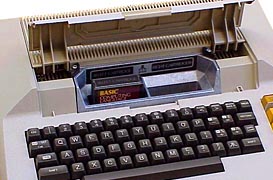
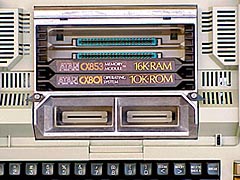
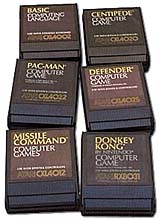 The cartridges are very handy, just plug 'em in and go! Technologically, there's not much to them,
just some ROM chips with the program already burned into them.
The cartridges are very handy, just plug 'em in and go! Technologically, there's not much to them,
just some ROM chips with the program already burned into them.
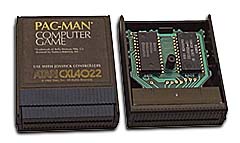
The Atari 800 has multiple special purpose co-processors for sound and graphics to take the load off of the 6502 CPU,
and it has sprites and collision-detection built into its hardware, so it is an excellent game machine.
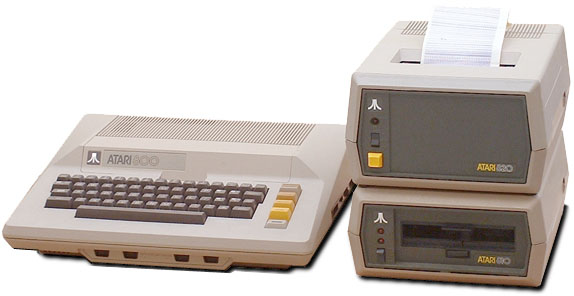 Up to four Atari 810 floppy drives ($599.95 each) can be hooked-up, allowing fast and reliable data storage.
Up to four Atari 810 floppy drives ($599.95 each) can be hooked-up, allowing fast and reliable data storage.
The floppy drive uses single-sided 5 1/4-inch floppy disks, holding 90K of data on a disk. The data is transfered in
serial format at 19200 baud.
The Atari 820 impact dot-matrix printer ($449.95) prints 40 columns of 5x7 characters, at approximately 40 characters per second.
The 810 and 820 are considered "intelligent" peripherals - they have built-in processor chips which lighten the load
on the computer's main processor. They can each be plugged directly into the Atari 400 or 800, with no other inteface required.
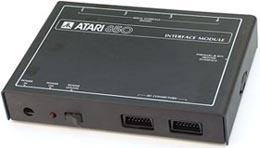
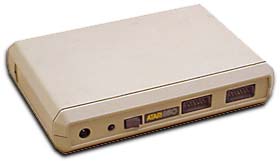
Unfortunately, the Atari 800 doesn't have any standard peripheral ports for non-Atari printers, modems, etc.
So in 1980, Atari released the Atari 850 Interface Module, which provides 4 separate RS-232-C serials ports
and a single Centronics compatible printer port.
There are two versions of the 850 as seen above. The black metal version on the left is the original unit and
is very uncommon. The newer version on the right is plastic.

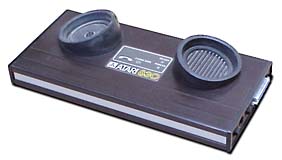 Seen here on the right is the first Atari modem, the Atari 830 Acoustic Couple Modem.
It has two cups on top to cradle the telephone handset, and it requires both the Atari 850
Interface Module (seen above) and the TeleLink I ROM cartridge (left) to operate.
Seen here on the right is the first Atari modem, the Atari 830 Acoustic Couple Modem.
It has two cups on top to cradle the telephone handset, and it requires both the Atari 850
Interface Module (seen above) and the TeleLink I ROM cartridge (left) to operate.
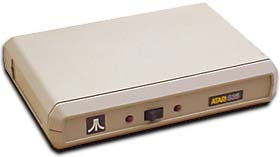 The second modem released was the Atari 835 Direct Connect Modem, a stand-alone unit which hooks
directly to the telephone line and does not use the 850 Interface Module. It does, however, require
the Atari Telelink II ROM cartridge.
The second modem released was the Atari 835 Direct Connect Modem, a stand-alone unit which hooks
directly to the telephone line and does not use the 850 Interface Module. It does, however, require
the Atari Telelink II ROM cartridge.
The 835 modem/cartridge pair features 300 baud upload/download speed, autodial, and they even remember
the last two numbers dialed!
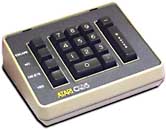
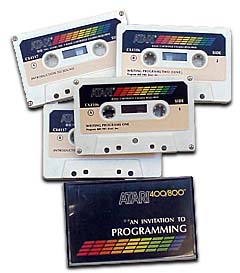 Additional accessories include the external keypad ($124.95) for fast data entry.
Additional accessories include the external keypad ($124.95) for fast data entry.
Although an external floppy drive was available, beginners often used the cheaper but less reliable cassette
tape drive.
Numerous games were released on cassette tape, and Atari produced introductory and programming tapes.
Like the Atari 400, the 800 was designed by a team which included Jay Miner, who later went on to help design
the Amiga 1000.
In 1983, Atari released a new and improved model - the Atari 1200XL.
It's supposed to be compatible with all Atari 800 software and peripherals, but it isn't.
|
|---|
Partial History of the Atari Computers |
- 196?: As an engineering student at the University of Utah, Nolan Bushnell liked to sneak into the computer labs
late at night to play computer games on the university's $7 million mainframes.
- 1972: Bushnell founded Atari with $250 of his own money and another
$250 from business partner Ted Dabney. They then created and commercialized the world's first
commercial video game, Pong. Bushnell was 27 years old.
- 1976: Warner Communications buys Atari from Bushnell for $28 million.
- 1977: Atari introduces the Atari Video Computer System (VCS), later renamed the Atari 2600
- 1978: December - Atari announces the Atari 400 and 800 personal computers.
- 1979: October - Atari begins shipping the Atari 400 and Atari 800 personal computers.
- 1979: December - Atari produces the first coin-operated Asteroids game machine.
- 1981: May - Atari announces the 8KB Atari 400 is being discontinued.
- 1982: January - Atari begins shipping all Atari 800 units with GTIA graphics chips, allowing three
more graphics modes than previously.
- 1982: December - Atari issues a US$55 rebate on the Atari 400, dropping its retail price to under US$200.
- 1983: January - Atari introduces the 1200XL home computer.
- 1983: May - Atari offers a US$100 rebate on the Atari 800, bringing its retail price to below US$400.
- 1983: June - Atari introduces the Atari 600 XL.
- 1983: June - Atari introduces the Atari 800 XL, with 64 KB RAM.
- 1983: June - Atari introduces the Atari 1450 XL, with built-in 300 bps modem.
- 1983: June - Atari introduces the Atari 1450 XLD, with built-in 300 bps modem and disk drive.
- 1983: October - Atari begins shipping its XL computers.
- 1983: - Atari cancels production of the Atari 1200XL, due to compatibility and other problems.
- 1984: July - Jack Tramiel, President of Commodore International, leaves Commodore in January and buys Atari.
- 1984: - Atari introduces the Atari 7800 ProSystem.
- 1985: January - Atari introduces the 65XE, for US$120.
- 1985: Atari introduces the 130XE, with 128KB RAM.
- 1985: Atari introduces the 130ST for US$400.
- 1985: Atari introduces the 520ST for US$600.
- 1987: January - At the Winter CES, Atari announces a US$1500 laser printer.
- 1988: September - Atari introduces the Atari TT.
- 1989: - Atari Computer introduces the Portfolio,
a 1-pound DOS-based PC, which runs on three AA batteries. Price: US$400
Source:
Chronology of Events in the History of Microcomputers
| |
|---|
|
Return to the Obsolete Technology Homepage

Copyright 2024
This page last updated on 05/07/2020 04:30:06
All logos and trademarks on this site are property of their respective owner.
|




 Seen here on the right is the first Atari modem, the Atari 830 Acoustic Couple Modem.
It has two cups on top to cradle the telephone handset, and it requires both the Atari 850
Interface Module (seen above) and the TeleLink I ROM cartridge (left) to operate.
Seen here on the right is the first Atari modem, the Atari 830 Acoustic Couple Modem.
It has two cups on top to cradle the telephone handset, and it requires both the Atari 850
Interface Module (seen above) and the TeleLink I ROM cartridge (left) to operate.
 The second modem released was the Atari 835 Direct Connect Modem, a stand-alone unit which hooks
directly to the telephone line and does not use the 850 Interface Module. It does, however, require
the Atari Telelink II ROM cartridge.
The second modem released was the Atari 835 Direct Connect Modem, a stand-alone unit which hooks
directly to the telephone line and does not use the 850 Interface Module. It does, however, require
the Atari Telelink II ROM cartridge.
